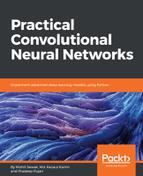CNNs, or ConvNets, are quite similar to regular neural networks. They are still made up of neurons with weights that can be learned from data. Each neuron receives some inputs and performs a dot product. They still have a loss function on the last fully connected layer. They can still use a nonlinearity function. All of the tips and techniques that we learned from the last chapter are still valid for CNN. As we saw in the previous chapter, a regular neural network receives input data as a single vector and passes through a series of hidden layers. Every hidden layer consists of a set of neurons, wherein every neuron is fully connected to all the other neurons in the previous layer. Within a single layer, each neuron is completely independent and they do not share any connections. The last fully connected layer, also called the output layer, contains class scores in the case of an image classification problem. Generally, there are three main layers in a simple ConvNet. They are the convolution layer, the pooling layer, and the fully connected layer. We can see a simple neural network in the following image:

So, what changes? Since a CNN mostly takes images as input, this allows us to encode a few properties into the network, thus reducing the number of parameters.
In the case of real-world image data, CNNs perform better than Multi-Layer Perceptrons (MLPs). There are two reasons for this:
- In the last chapter, we saw that in order to feed an image to an MLP, we convert the input matrix into a simple numeric vector with no spatial structure. It has no knowledge that these numbers are spatially arranged. So, CNNs are built for this very reason; that is, to elucidate the patterns in multidimensional data. Unlike MLPs, CNNs understand the fact that image pixels that are closer in proximity to each other are more heavily related than pixels that are further apart:
CNN = Input layer + hidden layer + fully connected layer - CNNs differ from MLPs in the types of hidden layers that can be included in the model. A ConvNet arranges its neurons in three dimensions: width, height, and depth. Each layer transforms its 3D input volume into a 3D output volume of neurons using activation functions. For example, in the following figure, the red input layer holds the image. Thus its width and height are the dimensions of the image, and the depth is three since there are Red, Green, and Blue channels:

